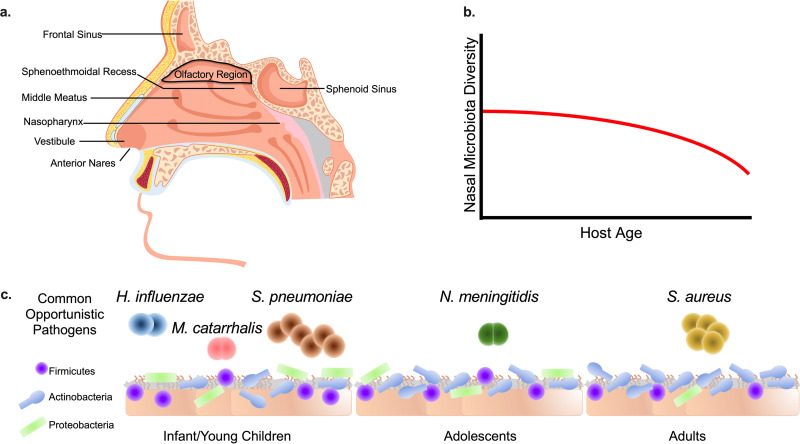FIG 1.
Nasal microbiota composition and structure change throughout life. (a) Nasal cavity anatomy and typical microbiota sampling sites (anterior nares, middle meatus, sphenoethmoidal recess, and nasopharynx) (6, 7). The anterior nares are the entrance to the nasal cavity and lead directly to the vestibule. The middle meatus is adjacent to the vestibule, and the nasopharynx connects to the throat. The sphenoethmoidal recess is located within the posterior portion of the nasal cavity. The olfactory region is located at the ceiling of the nasal cavity. The frontal and sphenoid sinuses are located within the facial skeleton. (b) The diversity of the nasal microbiota is variable between individuals but tends to decrease and stabilize within an individual’s lifetime, especially toward late adulthood (9). (c) The bacterial component of the nasal cavity is primarily composed of members of the Actinobacteria, Firmicutes, and Proteobacteria phyla (13). The abundance of each phylum changes over time (9, 10). During infancy, the nasal cavity typically resembles the mother’s vaginal/skin microbiota (11), with the Actinobacteria, Firmicutes, and Proteobacteria phyla predominating (70). Upon entering adolescence and adulthood, Proteobacteria are typically displaced by the Actinobacteria and Firmicutes phyla, especially in the anterior nares (13). Finally, in adulthood, the nasal microbiota structure remains relatively stable, and Actinobacteria predominate (7, 13). Infants and young children are often nasally colonized by the opportunistic pathogens S. pneumoniae, H. influenzae, and M. catarrhalis (21). Similarly, N. meningitidis often asymptomatically nasally colonizes adolescences and young adults (22). Approximately 25% of adults are colonized by S. aureus (31, 71).

